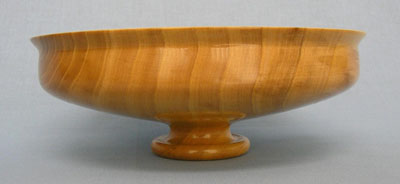
Here are My Woodturnings!
by Bob Ibach
Winona Lake, IN
Note: click any picture to see a larger version.
I like to seek inspiration that will entice me back to my lathe. Occasionally I remember the forms of ancient pottery I encountered in my study of the archaeology of Palestine. The most innovative and graceful pottery forms, in my opinion, were from the Middle Bronze II period, about 1925 to 1550 BC.
So I recently went back to some excavation reports and reviewed the drawings and descriptions of many of these ancient pots. A great variety came from tombs at the ancient city of Jericho, near the Dead Sea, excavated by the famous archaeologist Kathleen Kenyon. Drawings of many of these Middle Bronze II vessels appear in Excavations at Jericho, vol. I (British School of Archaeology in Jerusalem, 1960).
I selected several of my favorite forms and then attempted to turn those forms on my lathe.
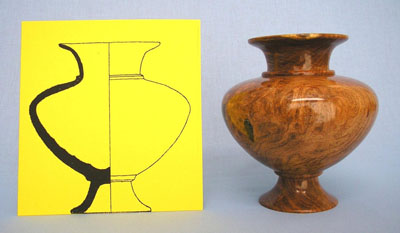
This graceful vase with pedestal base stands almost 6" high. The pottery original was found in Jericho tomb G 1 (Fig. 191, item #4); the drawing is scaled up from the excavation report. I turned this vessel from mesquite which I harvested in south Texas. I tried to duplicate the thickness of the walls, but my shoulder should have been slightly more angular. All items were finished with Waterlox.
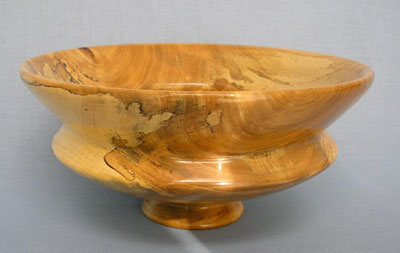
This item, characteristic of many bowls found at Jericho, is 8" in diameter. The lower part of the bowl is flared; this is called a carination point and is thought by some archaeologists to imitate metallic prototypes. I turned this object from spalted American elm. (Tomb B 35, item #11.)
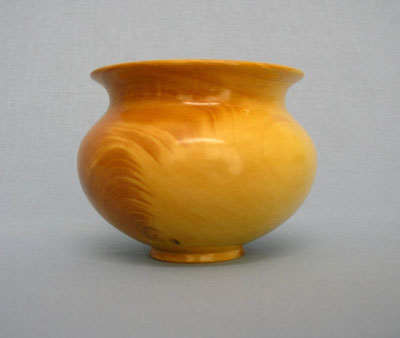
The pottery original of this little bowl, only 2.5" high, was found in Jericho tomb A 34 (Fig. 140, item #24). I turned this from a limb of ginkgo biloba. A bowl of this size has dubious functionality, but items placed with the dead were not particularly functional!
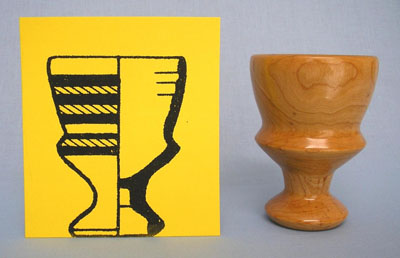
Goblets of this type were common in Middle Bronze II, and this one came from a tomb at the northern city of Megiddo (Ancient Pottery of the Holy Land, by Ruth Amiran, 1970, p. 98, item #9). I turned my imitation from a log of cherry found in the woods near my home.
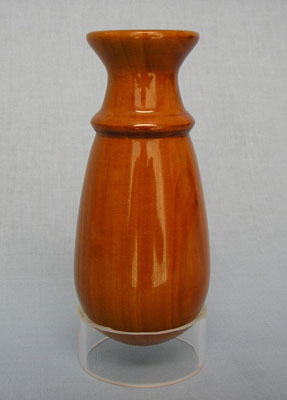
Although found at Jericho (tomb H 6, fig. 187, item #12) this bottle is quite different because the original was made of alabaster. It was less than 4" tall, but I scaled mine up to 5.5" and turned it from Bradford pear. Alabaster was a favorite material for small vessels that were used for perfume or other cosmetics. Obviously the original was not thrown on a fast wheel, nor turned on a lathe, but carved by hand. The original was only partially hollowed, leaving very thick walls.
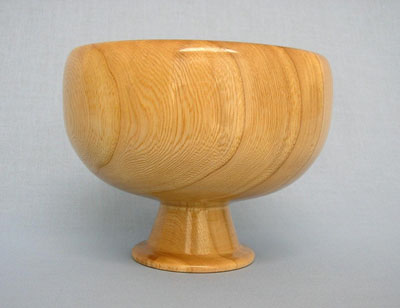
Here is a chalice, probably for cultic purposes, standing 4" high. The ceramic original was found at Megiddo (Amiran, Ancient Pottery of the Holy Land, p. 98, no. 13). I turned my version from American elm.

This shallow bowl, also found at Megiddo, has an everted rim 7" in diameter. The base is higher and smaller in diameter than would seem to be practical considering that the ancient folks of Palestine had almost no furniture that would provide a flat surface on which to place the bowls. My imitation was turned from American elm. (Megiddo Tombs, plate 26, item #12.)
This was an intriguing exercise for me even though, as my wife pointed out, my turnings do not look at all like they were made of clay! I came to appreciate the artistic talent and craftsmanship of the potters who lived almost 4,000 years ago. In the Early Bronze Age pottery was invariably hand made, but the fast wheel was introduced into Palestine in the Middle Bronze Age, and this seemed to spark a great deal of artistic innovation. Many forms were handleless, making them good candidates for imitation on the lathe.
You can email Bob at
paula.robertibach@gmail.com
.
Submit your own woodturnings or woodturning shop to this column! Simply
SEND US PHOTOS
of your woodturning
projects or shop along with captions and a brief history and description of your woodturning. (Email photos
at 800x600 resolution.) Receive a $50 store credit if we show your turning in a future issue!
